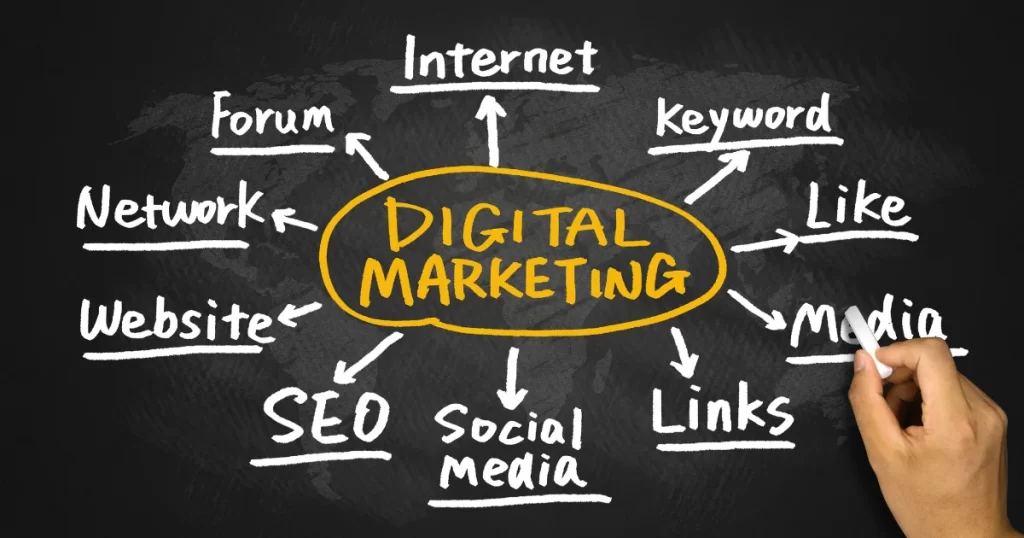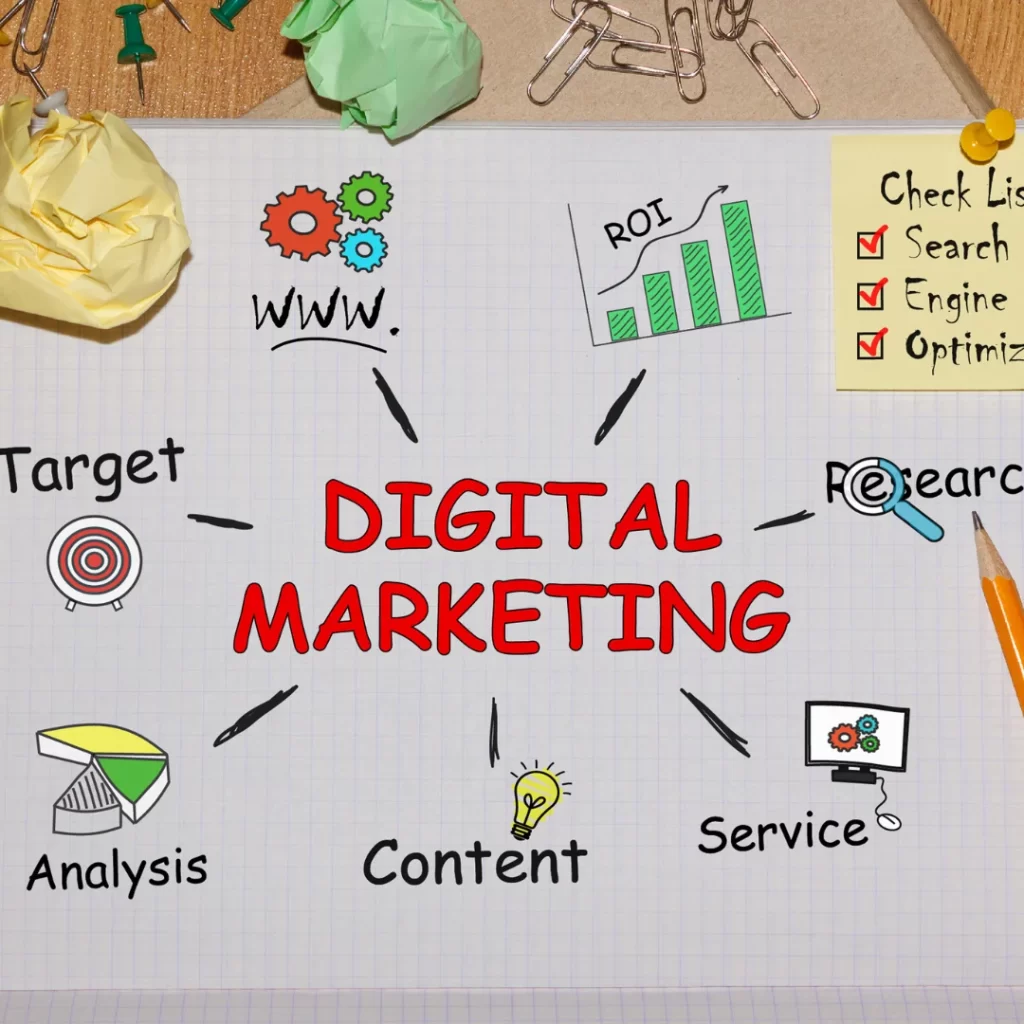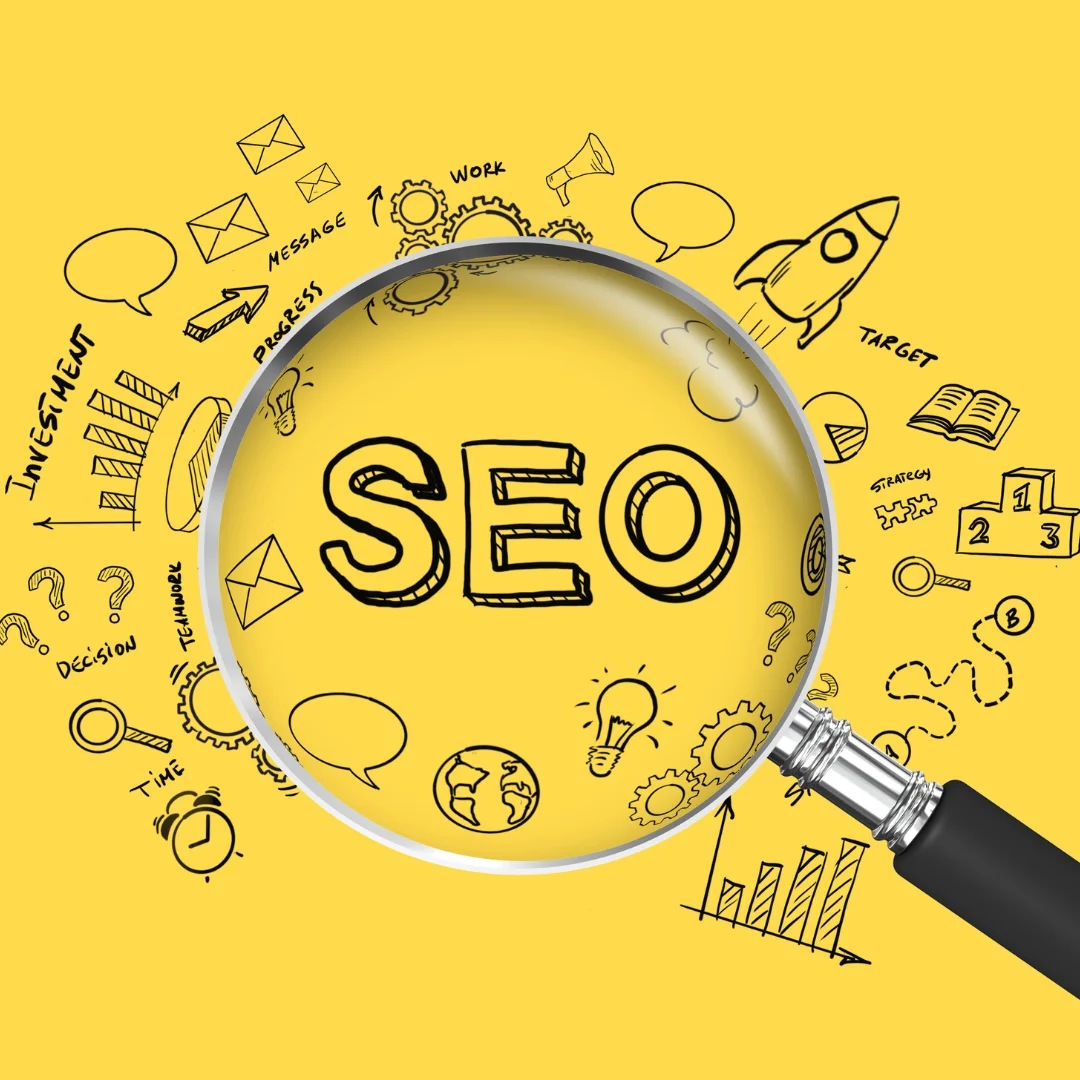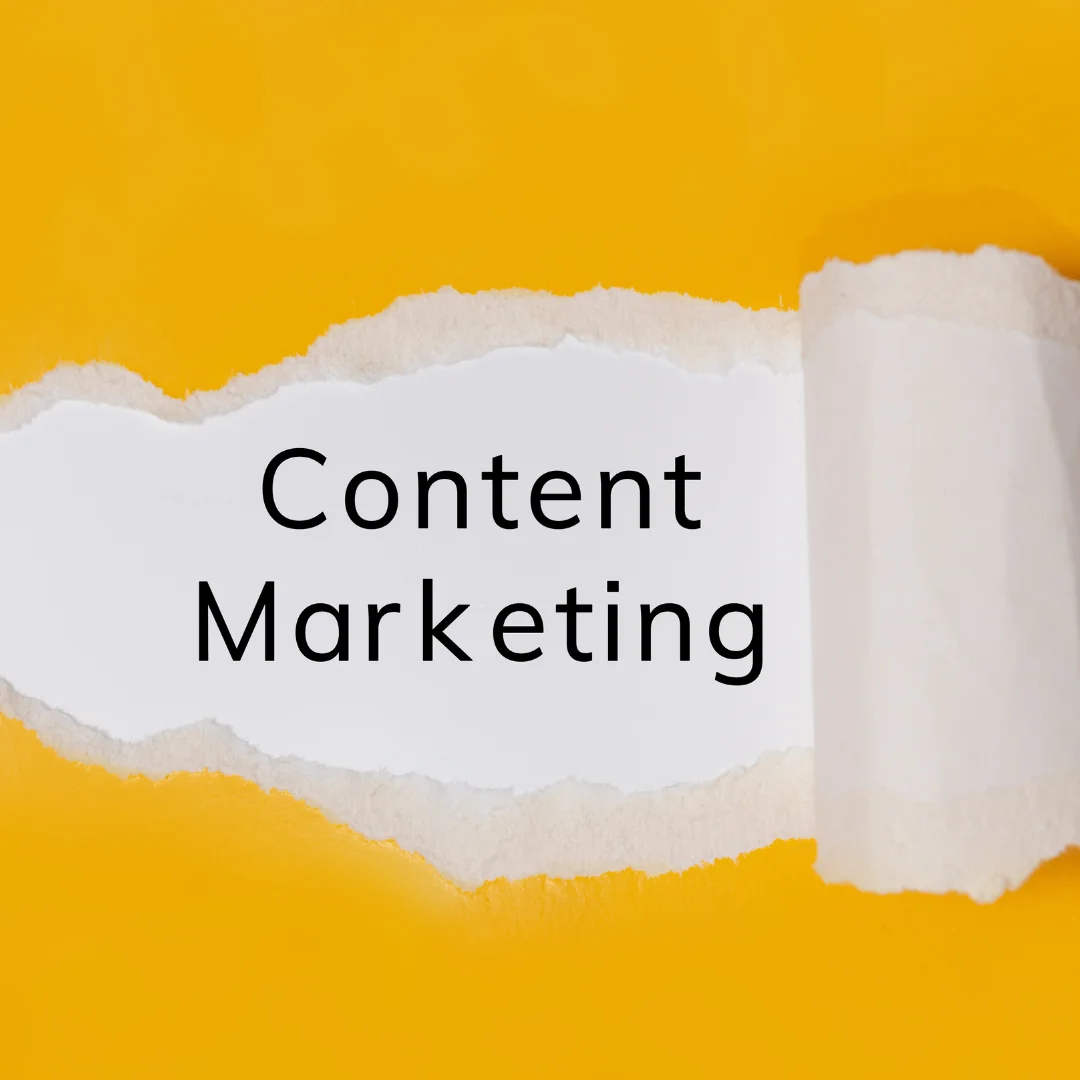
Digital marketing has fundamentally transformed how businesses engage with their audiences, making it a critical component of any successful strategy today. From its humble beginnings in the early 1990s—with the first clickable web ads marking the dawn of a new era—digital marketing has evolved into a powerful tool that businesses can leverage to reach potential customers where they spend the most time: online.
The Evolution of Digital Marketing
Initially, digital marketing consisted mainly of simple banner ads and email campaigns. However, as technology advanced and internet usage skyrocketed, digital marketing matured into a sophisticated field encompassing various strategies and channels. Today, it encompasses multiple forms, including Search Engine Optimization (SEO), Social Media Marketing (SMM), Content Marketing, and more. Each of these components plays a significant role in connecting brands with their target audiences.
The Importance of Digital Marketing
The significance of digital marketing lies in its ability to:
- Target Specific Audiences: Unlike traditional marketing methods, digital marketing allows for precise targeting. Marketers can identify specific demographics, interests, and behaviors, ensuring their messages reach the right people at the right time.
- Measure Success Accurately: One of the standout features of digital marketing is the ability to track performance in real-time. With tools like Google Analytics and social media insights, businesses can analyze data to measure the success of their campaigns and make informed decisions to optimize future efforts.
- Achieve Cost-Efficient Outcomes: Digital marketing often provides a more cost-effective alternative to traditional marketing. Small businesses, in particular, can compete with larger corporations by utilizing digital channels to promote their products and services without the high costs associated with print ads or TV commercials.
The Shift from Traditional to Digital Marketing
As consumer behavior shifted from print media, television, and radio to online platforms, digital marketing became essential. Today’s consumers are more connected than ever, using devices like smartphones, tablets, and laptops to seek information and make purchasing decisions. This shift has not only changed how brands communicate with their customers but also how they measure engagement and success.
Increased Competition
With more businesses recognizing the importance of digital marketing, the competition has intensified. Companies must now be strategic in their digital marketing efforts, focusing on innovative approaches to stand out in a crowded online marketplace. This includes understanding the various types of digital marketing, learning how to measure success through Key Performance Indicators (KPIs), and implementing effective strategies that yield maximum benefits.
A Necessity For All Businesses
Digital marketing is no longer an option; it is a necessity for businesses looking to thrive in the digital age. By understanding its various components and applying best practices, companies can build strong online presences that engage their audiences, drive traffic, and ultimately increase sales. As we delve deeper into the specifics of digital marketing, we will explore its types, key metrics, benefits, and best strategies for success.
Types of Digital Marketing

Digital marketing encompasses a variety of techniques designed to promote businesses online. Understanding and utilizing different types of digital marketing allows companies to build comprehensive strategies that resonate with their target audiences. Below are the most effective types of digital marketing.
1. Search Engine Marketing (SEM)
Search Engine Marketing (SEM) involves increasing the visibility of websites on search engine results pages (SERPs) through both paid advertising and organic optimization. SEM can be broken down into two major categories: Search Engine Optimization (SEO) and Paid Search Ads.
SEO focuses on driving organic traffic by optimizing a website’s structure, content, and keywords to rank higher on search engines. It’s about making the site more appealing to search engine algorithms and user-friendly for visitors. On the other hand, paid ads refer to bidding on keywords that trigger ad placements at the top of search results. This allows businesses to appear immediately in search results, but they pay for every click or impression their ads receive.
One of the primary benefits of SEM is its ability to drive highly targeted traffic—users who are actively searching for services or products. By strategically targeting the right keywords, SEM campaigns can be incredibly effective in converting searchers into customers.
| Key Element | Description |
|---|---|
| SEO | Organic optimization for search engines |
| Paid Ads | Paid listings on SERPs through keyword bidding |
“Search Engine Marketing is all about visibility, and the more visible you are in the search results, the more likely you are to capture the attention of your target audience.”
— Rand Fishkin, Co-founder of Moz
2. Social Media Marketing (SMM)
Social Media Marketing (SMM) leverages platforms like Facebook, Instagram, LinkedIn, and Twitter to reach and engage target audiences. It includes both organic and paid strategies. Organic SMM involves posting regular updates, interacting with followers, and sharing valuable content to build relationships and trust. Paid social media, on the other hand, refers to advertisements that are specifically targeted to user demographics, interests, and behaviors.
Social media marketing is unique because it allows businesses to interact with their audience in real time, building rapport and trust. It’s also one of the most effective ways to build brand awareness and create a community around a brand. With targeted ad campaigns, businesses can tailor their messaging to highly specific audience segments, ensuring greater relevance and engagement.
| Content Type | Description |
|---|---|
| Organic Posts | Regular updates and engagement with followers |
| Paid Ads | Targeted advertisements to reach specific demographics |
“Social media is about the people! Not about your business. Provide for the people, and the people will provide for you.”
— Matt Goulart, Founder of Ignite Digital
3. Content Marketing
Content Marketing is the creation and distribution of valuable, relevant, and consistent content to attract and engage a target audience. The primary goal of content marketing is to establish trust and authority by delivering content that educates, entertains, or solves a problem for the audience. This type of digital marketing includes blog posts, articles, videos, podcasts, infographics, white papers, and more.
Content marketing differs from traditional advertising in that it doesn’t directly promote a product or service. Instead, it builds a connection with the audience by providing useful information. Over time, this approach helps businesses establish themselves as thought leaders, leading to increased brand loyalty and conversions.
| Content Type | Example |
|---|---|
| Blog Posts | Informative articles on industry topics |
| Infographics | Visual representations of data and insights |
“Content marketing is the only marketing left.”
— Seth Godin, Bestselling Author
4. Email Marketing
Email Marketing is a highly effective tool for nurturing leads and maintaining direct communication with customers. This form of digital marketing allows businesses to send personalized messages to customers’ inboxes, whether in the form of newsletters, promotional offers, or transactional emails. Because emails can be tailored based on user behavior, preferences, or demographics, email marketing is a powerful tool for delivering highly relevant content.
The personalization factor in email marketing makes it one of the best ways to nurture relationships with prospects and existing customers. Automated emails—such as welcome series, abandoned cart emails, or re-engagement campaigns—can keep the audience engaged and drive conversions over time.
| Email Type | Example |
|---|---|
| Newsletters | Regular updates about business or industry trends |
| Promotional Offers | Discounts or special deals sent to targeted customers |
“Email has an ability many channels don’t: creating valuable, personal touches—at scale.”
— David Newman, Speaker and Author
5. Affiliate Marketing
Affiliate Marketing is a performance-based strategy in which businesses partner with individuals or other companies (affiliates) to promote their products or services. In this model, affiliates earn a commission for every sale, lead, or action generated through their marketing efforts. The beauty of affiliate marketing is that it allows companies to extend their reach without upfront advertising costs.
Affiliates use different channels—blogs, websites, email campaigns, and social media—to promote products. Because affiliates are often content creators or influencers with their own audience base, this type of digital marketing can be very effective in targeting niche markets. Businesses pay affiliates based on performance, which minimizes financial risk.
| Key Element | Description |
|---|---|
| Commission Structure | Affiliates earn based on sales or leads generated |
| Promotion Channels | Blogs, social media, or email marketing |
6. Video Marketing
Video Marketing involves using video content to promote a brand, product, or service. With platforms like YouTube, TikTok, and Instagram gaining massive popularity, video marketing has become an essential part of any digital marketing strategy. Videos are engaging, easily digestible, and highly shareable, making them one of the most effective content formats for driving traffic and conversions.
From product demonstrations and customer testimonials to live streams and how-to videos, businesses can use video content to showcase their expertise and connect with their audience on a deeper level. Video marketing can significantly enhance brand storytelling and emotional appeal, leading to higher customer engagement and retention.
“Video is not just a piece of your marketing plan; it is central to your outreach and campaign efforts.”
— James McQuivey, Principal Analyst at Forrester Research
7. Display Advertising
Display Advertising refers to placing visual ads on websites, social media platforms, or apps. These ads come in various formats such as banners, pop-ups, or sidebars, and they are designed to attract users’ attention while they browse online. Display ads can be highly effective for increasing brand visibility, particularly when combined with retargeting strategies that reach users who have previously visited a business’s website.
With advancements in programmatic advertising, businesses can automate the buying and placement of display ads, ensuring they reach the right audience at the right time. By targeting users based on their browsing behavior or demographics, display advertising helps to capture attention and encourage further engagement with the brand.
| Ad Type | Description |
|---|---|
| Banner Ads | Visual ads displayed on websites or apps |
| Retargeting Ads | Ads that target users who have previously interacted with the brand |
Key Performance Indicators (KPIs) in Digital Marketing

Understanding Key Performance Indicators (KPIs) is essential to measuring the success of any digital marketing campaign. KPIs are the metrics that reflect how well strategies are performing and offer insights into where adjustments are necessary to improve outcomes. They help businesses track their marketing goals and ROI, ensuring that efforts align with desired results. Below are the primary KPIs used in digital marketing to evaluate success.
1. Clickthrough Rate (CTR)
Clickthrough Rate (CTR) is one of the most commonly tracked KPIs in digital marketing. CTR measures the percentage of people who click on a digital ad, email link, or call-to-action button after viewing it. This metric helps marketers assess how well an ad or piece of content captures the audience’s attention and prompts them to take action.
A high CTR is a strong indicator that your content or ad is engaging, relevant, and well-targeted to the audience. Conversely, a low CTR may suggest that the content needs refinement or the audience targeting needs adjustment. CTR is particularly important in paid advertising campaigns, such as Google Ads, where businesses are charged per click, making it crucial to ensure those clicks are valuable.
| Metric | Definition | Purpose |
|---|---|---|
| Clickthrough Rate (CTR) | Percentage of users who click on a link or ad | Measures ad engagement and relevancy |
How to Improve CTR:
- Use compelling and clear headlines.
- Include a strong call-to-action (CTA).
- A/B tests different ad designs and messaging.
2. Conversion Rate
Conversion Rate is a vital KPI in digital marketing because it measures how many users complete a desired action, such as making a purchase, signing up for a newsletter, or filling out a contact form. This metric directly reflects the effectiveness of your marketing efforts in driving leads or sales.
A high conversion rate suggests that the marketing campaign successfully encourages users to take the next step in their buyer’s journey. Conversion rate optimization (CRO) involves refining landing pages, user experience (UX), and CTAs to increase the percentage of visitors who convert. Whether your goal is sales, lead generation, or other actions, monitoring conversion rates helps pinpoint areas that need improvement.
| Metric | Definition | Purpose |
|---|---|---|
| Conversion Rate | Percentage of users who complete a desired action | Measures success in achieving goals like purchases or sign-ups |
How to Improve Conversion Rate:
- Simplify and clarify the user journey.
- Optimize landing pages for speed and functionality.
- Personalize your offers based on user data.
3. Website Traffic
Website Traffic is a fundamental KPI for assessing the overall success of a digital marketing strategy. It measures the number of visitors that come to a website over a given period. By analyzing website traffic, marketers can gauge how well their marketing efforts are driving people to their site, whether through organic search, paid ads, or social media.
However, simply increasing traffic isn’t enough—quality traffic matters. It’s essential to analyze traffic sources to understand whether visitors are coming from search engines, social media, direct visits, or referrals. Furthermore, tracking traffic trends can help identify patterns and opportunities for optimizing traffic-driving campaigns.
| Traffic Source | Definition |
|---|---|
| Organic Traffic | Visitors from search engines through unpaid results |
| Paid Traffic | Visitors from ads, such as Google Ads or Facebook Ads |
| Referral Traffic | Visitors from other websites linking to your site |
| Direct Traffic | Visitors who directly type your URL into their browser |
How to Improve Website Traffic:
- Optimize for SEO to increase organic traffic.
- Run targeted ad campaigns to attract relevant users.
- Share engaging content on social media.
4. Engagement Metrics
Engagement Metrics are critical for understanding how audiences interact with your content, particularly on social media platforms. Engagement goes beyond just the number of likes or shares—it indicates the level of interest and connection users have with your brand. Common engagement metrics include likes, shares, comments, clicks, and video views.
High engagement suggests that your content resonates with your audience and encourages them to participate. This can lead to improved brand loyalty and increased visibility as users share and engage with your content. On platforms like Facebook, Instagram, and LinkedIn, engagement metrics are crucial for optimizing content strategies and ensuring that posts reach a wider audience.
| Metric | Definition | Purpose |
|---|---|---|
| Likes & Reactions | The number of positive interactions with content | Measures initial interest |
| Shares & Retweets | The number of times content is shared with others | Increases brand reach |
| Comments & Replies | User feedback and conversation around the content | Measures deeper engagement |
How to Improve Engagement:
- Create content that encourages interaction (e.g., polls, questions).
- Respond to comments and foster a two-way conversation.
- Post consistently and at times when your audience is most active.
5. Return on Investment (ROI)
Return on Investment (ROI) is arguably the most important KPI for businesses when evaluating their digital marketing efforts. ROI measures the profitability of a campaign by comparing the revenue generated from the campaign to the amount spent. In other words, ROI tells you whether your marketing efforts are delivering value for the investment.
For a successful digital marketing strategy, it’s essential to achieve a positive ROI. This means that the revenue or leads generated from your campaign should exceed the costs associated with running it. ROI calculations help businesses make data-driven decisions about where to allocate their marketing budget for maximum impact.
| Metric | Definition | Purpose |
|---|---|---|
| Return on Investment (ROI) | Profit earned from digital marketing efforts compared to the cost | Measures campaign profitability |
How to Improve ROI:
- Focus on high-converting channels.
- Continuously optimize your ad spend.
- Track and refine KPIs like CTR and conversion rate.
7 Benefits of Digital Marketing

Digital marketing has revolutionized how businesses approach advertising and audience engagement. By leveraging the power of digital channels, companies can reach more people, engage directly with their target audience, and adjust their strategies in real time based on performance data. Below, we’ll explore seven key benefits of digital marketing and how they can give businesses a competitive edge in today’s market.
1. Cost-effectiveness
One of the most significant advantages of digital marketing is its cost-effectiveness. Traditional advertising methods such as TV commercials, radio spots, and print ads require substantial financial investment. In contrast, digital marketing enables businesses, even small and medium-sized ones, to compete on a much smaller budget. Through techniques like search engine optimization (SEO), social media marketing (SMM), and email marketing, companies can reach their audience without breaking the bank.
For instance, pay-per-click (PPC) advertising ensures that businesses only pay when a user clicks on their ad, allowing them to control costs and monitor ROI closely. Additionally, digital marketing campaigns can be tailored to fit any budget, enabling businesses to scale their efforts as they grow.
| Method | Cost | ROI |
|---|---|---|
| SEO | Low | High |
| Social Media Marketing | Low to Medium | High |
| Pay-per-click (PPC) Ads | Flexible | High |
| Traditional Print/TV Ads | High | Medium |
Key Takeaway: Digital marketing's cost-effectiveness makes it accessible for businesses of all sizes, ensuring a high return on investment (ROI) without hefty upfront costs.
2. Wider Reach through Digital Channels
Unlike traditional marketing, which often has geographic limitations, digital marketing offers businesses the opportunity to reach a global audience. Through various channels like SEO, social media, and email marketing, businesses can connect with customers from different parts of the world without additional effort.
With the rise of social media platforms and search engines, businesses no longer need to be restricted to a local market. They can now promote their products or services to audiences in different cities, countries, or continents. Whether through organic traffic generated by SEO or paid advertising through platforms like Google Ads and Facebook Ads, digital marketing enables companies to expand their reach far beyond traditional methods.
| Digital Channel | Reach | Cost |
|---|---|---|
| Social Media | Global | Low to Medium |
| SEO | Global | Low |
| Google Ads | Local to Global | Flexible |
| Email Marketing | Global | Low |
Key Takeaway: Businesses can access global markets through digital marketing, increasing opportunities to connect with new audiences and grow their customer base.
3. Targeted Advertising
One of the standout features of digital marketing is the ability to target specific demographics, interests, and behaviors with pinpoint accuracy. Platforms like Google Ads and Facebook Ads allow businesses to tailor their campaigns to specific audience segments based on factors such as age, location, interests, online behaviors, and purchasing patterns.
Targeted advertising ensures that marketing efforts reach the most relevant audience, significantly improving the chances of converting leads into customers. This precision targeting saves businesses from wasting money on broad, non-specific campaigns that may not reach the right people.
“The beauty of digital marketing is that it allows you to hyper-target your audience, which significantly increases the chances of converting prospects into customers.”
— Larry Kim, CEO of MobileMonkey
| Platform | Targeting Options | Purpose |
|---|---|---|
| Google Ads | Demographics, Interests, Keywords | Reach relevant users searching for products |
| Facebook Ads | Interests, Behaviors, Lookalikes | Target users based on online activity |
| LinkedIn Ads | Job Titles, Industries, Companies | Reach B2B audiences with specific job roles |
Key Takeaway: With targeted advertising, businesses can focus their marketing budget on high-potential customers, improving conversion rates and maximizing ROI.
4. Measurable Results
A major advantage of digital marketing is the ability to measure performance in real time. Tools like Google Analytics and Facebook Insights provide detailed reports on metrics such as website traffic, conversion rates, click-through rates (CTR), and more. This data allows businesses to monitor the success of their campaigns and make data-driven decisions to optimize future marketing strategies.
In contrast to traditional marketing, where it can be challenging to track the direct impact of an ad campaign, digital marketing allows for complete transparency. Every aspect of a campaign—from the number of impressions to the total conversions—can be measured, giving marketers a clear view of their return on investment (ROI).
| Metric | Measurement Tool | Purpose |
|---|---|---|
| Website Traffic | Google Analytics | Measure site visitors and traffic sources |
| Conversion Rate | Google Ads | Track actions taken, like purchases or sign-ups |
| Social Engagement | Facebook Insights | Monitor likes, shares, and comments |
Key Takeaway: With the ability to measure every aspect of a campaign, digital marketing enables businesses to track their progress and adjust strategies in real time for optimal results.
5. Improved Engagement
One of the unique benefits of digital marketing is its ability to foster direct interaction between businesses and their customers. Through platforms like Facebook, Instagram, and Twitter, businesses can engage with their audience through comments, messages, and other social interactions. This builds stronger customer relationships and promotes brand loyalty.
Engaging with customers online also provides businesses with valuable feedback, helping them better understand their audience’s preferences and needs. Responding to comments or inquiries in real time can enhance customer satisfaction and foster a sense of community around the brand.
| Social Platform | Engagement Type | Purpose |
|---|---|---|
| Comments, Shares | Foster conversations around content | |
| Likes, DMs | Engage directly with customers | |
| Retweets, Replies | Respond to inquiries and build community |
Key Takeaway: By engaging with customers directly, businesses can improve customer satisfaction, build brand loyalty, and gain valuable insights into their audience’s needs.
6. Brand Awareness
Digital marketing offers several methods for boosting brand awareness, one of which is through collaborations with influencers. By partnering with influencers—social media personalities with large, loyal followings—businesses can expand their reach and gain access to a new audience segment. Influencers act as ambassadors for brands, promoting their products or services to a wider audience.
Additionally, social media campaigns are another powerful tool for building brand awareness. Creative campaigns that encourage user participation, such as contests or giveaways, can lead to increased visibility and brand recognition.
| Method | Purpose | Benefit |
|---|---|---|
| Influencer Marketing | Leverage influencer followings | Access new audiences and boost credibility |
| Social Media Campaigns | Encourage user participation | Increase brand visibility and engagement |
Key Takeaway: Collaborating with influencers and running creative social media campaigns can significantly boost brand awareness and position your business as a leader in the industry.
7. Flexibility and Adaptability
Digital marketing offers unparalleled flexibility, allowing businesses to adapt their strategies based on real-time performance data. With A/B testing, companies can test different versions of their ads, landing pages, or email campaigns to determine which performs best. This enables marketers to fine-tune their approach, improving the effectiveness of their campaigns.
The adaptability of digital marketing ensures that businesses can quickly pivot in response to market changes, audience preferences, or performance insights. Whether it’s updating an underperforming ad or adjusting targeting parameters, digital marketing allows for constant refinement.
| Strategy | Flexibility | Purpose |
|---|---|---|
| A/B Testing | Test ad variations | Improve ad performance |
| Campaign Adjustments | Change target demographics or ad copy | Adapt to audience behavior |
Key Takeaway: The flexibility of digital marketing allows businesses to continuously improve their campaigns by adapting to data and audience insights in real time.
Best Strategies For Digital Marketing Success

To achieve success in digital marketing, businesses need to implement strategies that align with their objectives and leverage the power of online platforms. The right approach not only increases visibility but also enhances engagement, boosts conversions, and maximizes return on investment (ROI). Here’s a deeper dive into the best strategies for succeeding in the ever-evolving world of digital marketing.
1. Focus on SEO and SEM
Search engine optimization (SEO) and search engine marketing (SEM) are the foundations of any successful digital marketing strategy. SEO involves optimizing your website content, structure, and technical elements to ensure that search engines can easily index and rank your site. The goal is to rank higher in organic search results for relevant keywords, which increases your website’s visibility and attracts more traffic.
- On-page SEO: Focus on optimizing individual web pages by incorporating target keywords into content, meta tags, headers, and URLs. Additionally, ensure that your site has fast loading times and is mobile-friendly.
- Off-page SEO: Build quality backlinks from reputable sites, engage in guest blogging, and promote your content across social media channels to boost your website’s authority.
- SEM: While SEO is a long-term strategy, SEM involves paid search advertising, such as Google Ads or Bing Ads, to quickly appear in top search results. This combination of organic and paid search marketing creates a holistic approach to boosting traffic.
| SEO Tactics | Focus | Benefit |
|---|---|---|
| On-Page Optimization | Keywords, Meta Tags | Boosts visibility in search rankings |
| Off-Page SEO | Link Building | Increases authority and trust |
| SEM | Paid Search Ads (PPC) | Quick traffic and visibility |
Key Takeaway: A strong SEO and SEM strategy ensures long-term visibility and attracts qualified leads, combining organic efforts with paid tactics to drive traffic efficiently.
2. Leverage Social Media Platforms
Establishing a robust presence on social media is essential for businesses looking to succeed in digital marketing. Social media platforms like Facebook, Instagram, LinkedIn, and Twitter offer businesses a way to connect directly with their audience, build brand loyalty, and increase awareness.
Effective social media strategies include:
- Consistent posting: Regularly share content that resonates with your audience, such as blog posts, promotions, behind-the-scenes content, or user-generated content.
- Engagement: Interact with your followers by responding to comments, liking posts, and engaging in conversations. This fosters a sense of community and encourages loyalty.
- Targeted ads: Utilize the advanced targeting options on platforms like Facebook or LinkedIn to run ads aimed at specific demographics, job titles, or interests. This ensures your ad dollars are spent reaching the right people.
| Platform | Primary Use | Audience |
|---|---|---|
| B2C and B2B brand engagement | Broad and diverse demographics | |
| Visual content and stories | Younger audience and visual consumers | |
| B2B networking and professional growth | Business professionals and executives |
Key Takeaway: Social media is crucial for building a direct connection with your audience, increasing brand visibility, and driving engagement through organic content and targeted ads.
3. Use Data Analytics to Inform Decisions
Data is at the heart of effective digital marketing. To optimize campaigns and ensure success, businesses must track, measure, and analyze their marketing efforts using tools like Google Analytics, Facebook Insights, or HubSpot.
- Website performance: Monitor traffic, bounce rates, and user behavior on your site. This data reveals what’s working and what needs improvement, allowing for more informed decisions on content or design adjustments.
- Conversion tracking: Track the effectiveness of different marketing channels, such as PPC ads or email campaigns, by setting up goals for specific actions like sign-ups or purchases.
- A/B testing: Experiment with different variations of ads, emails, or landing pages to determine which performs better. This data-driven approach optimizes conversion rates.
| Metric | Measurement Tool | Purpose |
|---|---|---|
| Traffic Sources | Google Analytics | Track where visitors are coming from |
| Conversion Rate | Google Ads | Measure success of PPC campaigns |
| Email Open Rates | Mailchimp, HubSpot | Gauge email campaign effectiveness |
Key Takeaway: Leveraging data analytics allows businesses to make data-driven decisions that enhance the effectiveness of their digital marketing campaigns and improve ROI.
4. Implement Email Marketing Campaigns
Despite the rise of social media, email marketing remains one of the most effective ways to engage with customers. It offers a direct line of communication to your audience, enabling you to share updates, promotions, and personalized content.
Successful email marketing strategies include:
- Segmented lists: Divide your email list based on customer behavior, demographics, or preferences. This enables more targeted campaigns and increases the likelihood of conversions.
- Personalized content: Tailor your emails to individual recipients by addressing them by name and offering recommendations based on their past interactions with your brand.
- Automation: Use tools like Mailchimp or Constant Contact to automate emails, such as welcome series, abandoned cart reminders, or birthday promotions.
| Email Type | Purpose | Benefit |
|---|---|---|
| Welcome Series | Onboarding new subscribers | Builds initial relationship |
| Promotional Emails | Sharing discounts, sales, or offers | Encourages immediate action |
| Abandoned Cart Emails | Reminding customers to complete purchases | Increases conversion rates |
Key Takeaway: Email marketing is a powerful tool for nurturing leads, driving conversions, and maintaining long-term customer relationships.
5. Invest in Video Content
As the demand for visual content grows, businesses must invest in video marketing to remain competitive. Video content allows brands to showcase their products, explain their services, and share their stories in a highly engaging format.
Types of video content to consider:
- Product demos: Demonstrate how your product works, highlight its features, and show how it can solve customer pain points.
- Behind-the-scenes: Offer a glimpse into your company culture or manufacturing process, which helps humanize your brand and build trust.
- Customer testimonials: Share success stories from satisfied customers, providing social proof that can influence potential buyers.
| Video Type | Purpose | Platform |
|---|---|---|
| Product Demo | Showcases product features | YouTube, Social Media |
| Customer Testimonial | Builds trust with social proof | Website, YouTube, Social Media |
| Behind-the-Scenes | Humanizes the brand | Social Media, YouTube |
Key Takeaway: Video content is an engaging and effective way to communicate with your audience, improve brand awareness, and build trust with potential customers.
6. Prioritize Mobile Optimization
With the increasing use of mobile devices for browsing, shopping, and social media, it’s essential to prioritize mobile optimization in your digital marketing strategy. A mobile-friendly website not only enhances the user experience but also impacts your search engine rankings.
Key aspects of mobile optimization include:
- Responsive design: Ensure your website adapts to different screen sizes and loads quickly on mobile devices.
- Mobile-friendly content: Create content that’s easy to read and navigate on smaller screens, including shorter paragraphs, larger fonts, and clear calls to action.
- Mobile ads: Invest in mobile-specific ads that target users browsing on their phones, such as Google Ads or Facebook Ads optimized for mobile devices.
| Element | Focus | Impact |
|---|---|---|
| Responsive Design | Adapts layout to different screen sizes | Enhances user experience |
| Mobile-Friendly Content | Clear, concise, and easy to navigate | Improves engagement and conversions |
| Mobile Ads | Ads optimized for mobile platforms | Reaches users on-the-go |
Key Takeaway: Mobile optimization ensures that your website delivers a seamless experience for users on smartphones, which is essential for maximizing traffic and conversions.
7. Stay Updated with Digital Trends
The world of digital marketing is constantly evolving, with new technologies, platforms, and techniques emerging regularly. Staying informed about the latest trends helps businesses remain competitive and innovative in their marketing efforts.
Emerging trends to keep an eye on include:
- Artificial intelligence (AI): AI is transforming digital marketing through tools like chatbots, personalized content recommendations, and automated advertising.
- Voice search: With the growing popularity of voice-activated devices like Amazon Alexa and Google Home, optimizing your content for voice search is becoming increasingly important.
- Programmatic advertising: This automated form of ad buying uses data and AI to target ads more precisely, improving ad performance and reducing costs.
| Trend | Description | Benefit |
|---|---|---|
| Artificial Intelligence | Automates tasks like chatbots or ads | Increases efficiency and personalization |
| Voice Search | Optimizes for spoken search queries | Reaches users with voice-activated devices |
| Programmatic Advertising | Automated ad targeting using AI | Improves ad precision and performance |
Key Takeaway: Staying updated with the latest trends ensures your business remains competitive and takes advantage of cutting-edge tools and techniques in digital marketing.
Conclusion
Digital marketing has redefined how businesses connect with their audiences. Through various channels like SEO, social media, and email marketing, companies can reach targeted consumers, measure performance, and achieve cost-effective results. Understanding the different types of digital marketing, key performance indicators, and best strategies is crucial for businesses looking to succeed in the digital landscape. By leveraging the benefits of digital marketing and staying adaptable to new trends, companies can build a strong online presence and drive long-term success.





